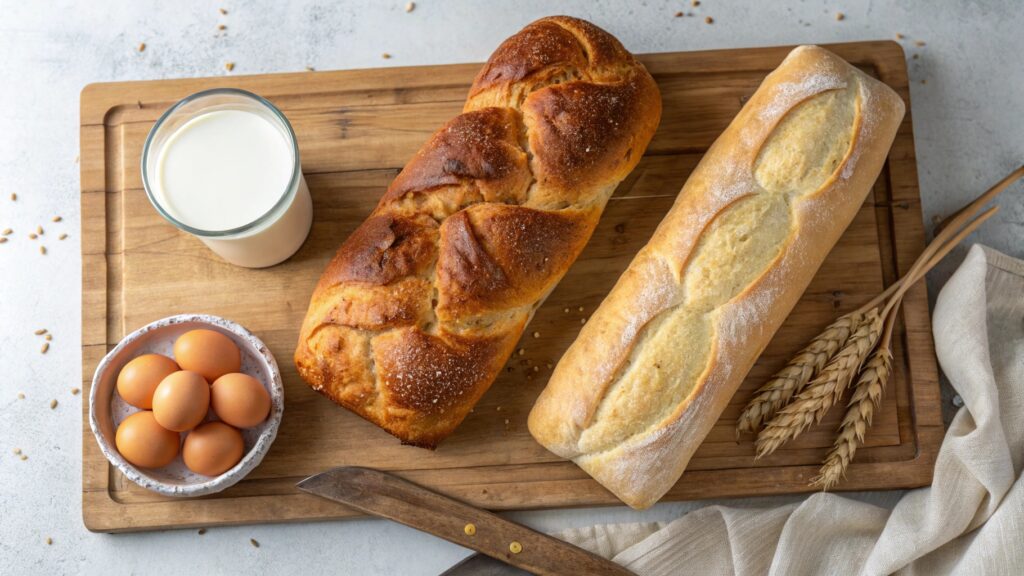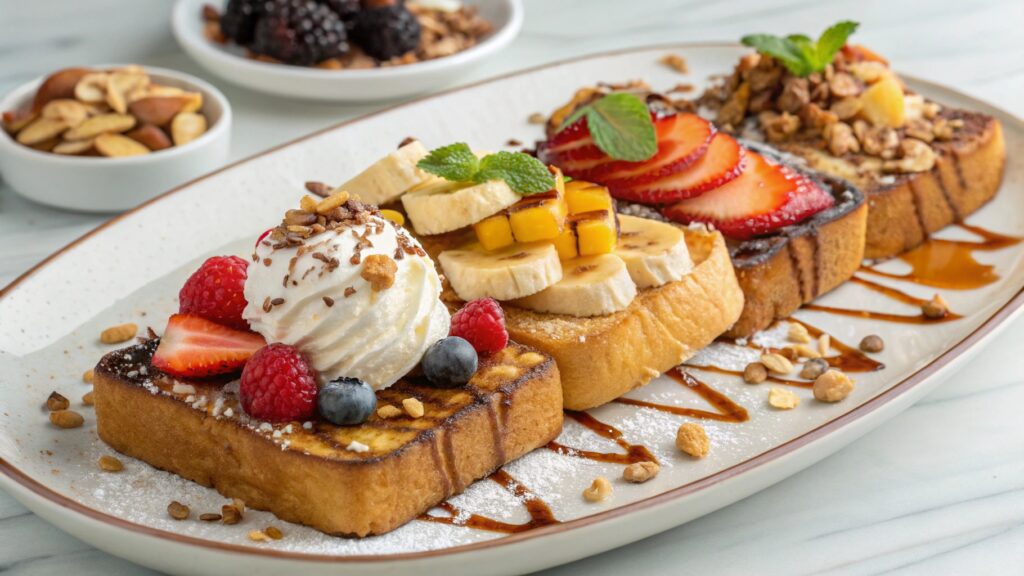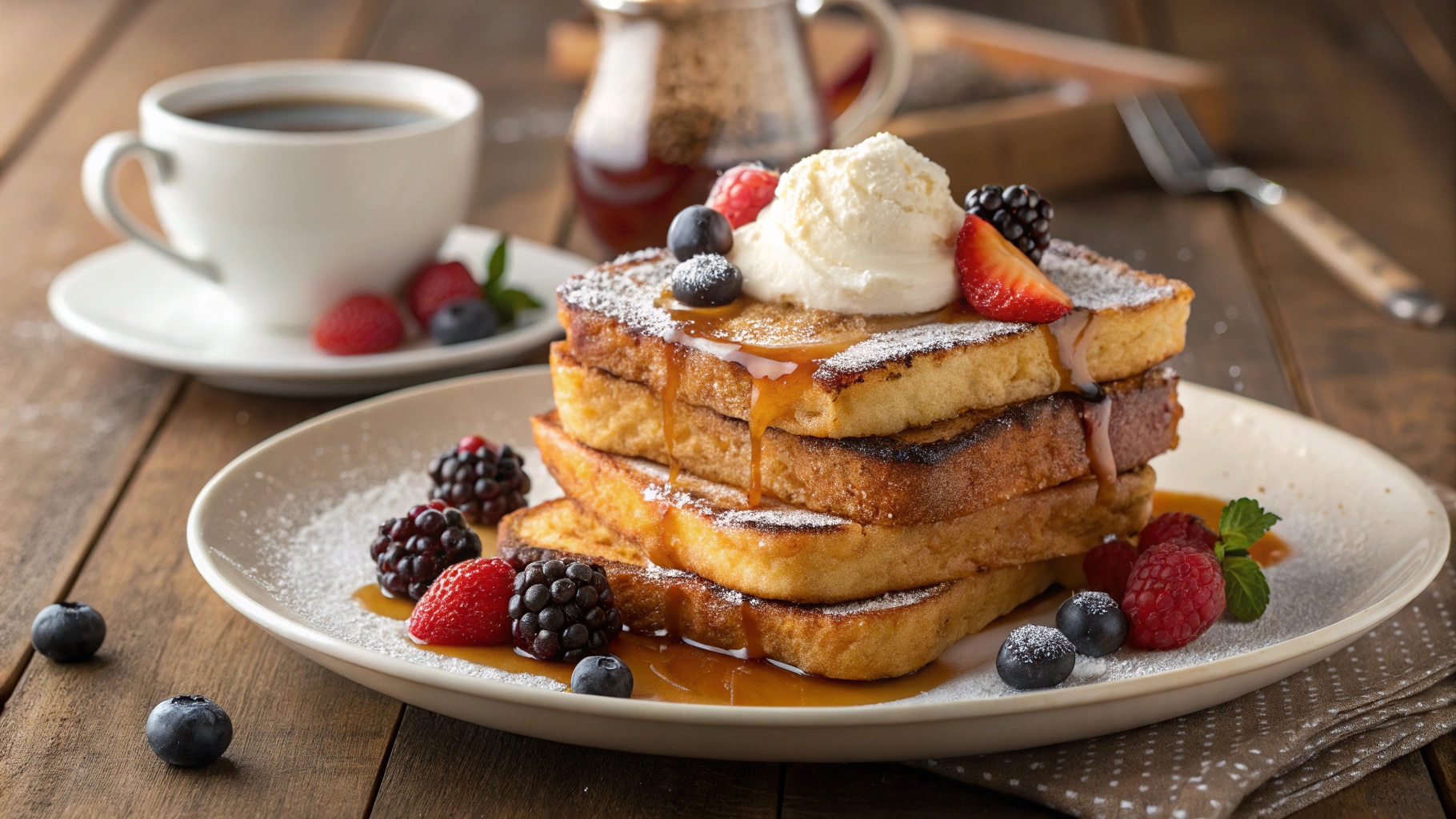French toast is a breakfast favorite, but do you know the most common mistake people make when preparing it? 🍞✨ It’s trickier than it looks, and a single misstep can leave you with a soggy disaster. The main culprit? Choosing the wrong bread! But don’t worry we’ve got you covered. Follow our step-by-step guide to achieve perfectly golden, delicious French toast every time. Let’s uncover the secrets together!
Table of Contents
Introduction to French Toast
A Brief History of French Toast
Did you know that French toast isn’t really French? Shocking, right? 😲 Its roots trace back to ancient Rome, where stale bread was soaked in milk and eggs to avoid waste. Over time, cultures worldwide adopted their own versions of this dish. In France, it’s called pain perdu, or “lost bread,” referring to how they transform old, forgotten bread into something heavenly. Romantic, isn’t it?
Why French Toast Remains a Breakfast Favorite
So why is French toast still a crowd-pleaser after centuries? For starters, it’s quick, comforting, and incredibly versatile. Whether you prefer it dripping with syrup, topped with fresh fruits, or stuffed with creamy fillings, French toast caters to everyone’s taste buds. But here’s the deal: even the best recipes can flop if you make certain rookie mistakes. And it all starts with your choice of bread.
The Most Common Mistake: Using the Wrong Bread
Why Bread Selection Matters
Imagine biting into your French toast and realizing it’s soggy, tasteless, or falling apart. Gross, right? 😬 That’s what happens when you pick the wrong bread. Bread isn’t just a base; it’s the canvas for your masterpiece. A sturdy, slightly dry bread is key to absorbing the egg mixture without turning into mush.
Types of Bread to Avoid
Let’s get straight to it here are the breads you should avoid at all costs:
- Fresh Sandwich Bread: It’s too soft and falls apart.
- Whole Wheat Bread: While healthy, its texture doesn’t suit French toast.
- Gluten-Free Bread: Unless specifically made for French toast, it often crumbles.
Best Bread Choices for Perfect French Toast

Now that we’ve covered the “no-go” list, let’s talk about winners. Here are your top choices for bread:
| Bread Type | Why It’s Perfect |
|---|---|
| Brioche | Rich, buttery, and indulgent. A French toast superstar! 🥖 |
| Challah | Soft but sturdy, with a hint of sweetness. |
| French Baguette | Crusty on the outside, tender inside. Perfect for soaking! |
“The secret to French toast starts with the bread. Choose wisely, and you’re halfway to breakfast bliss.”
Mistakes in the Egg and Milk Mixture
Common Issues with the Ratio of Egg to Milk
Now, let’s talk about the batter the heart of your French toast. Many people mess up by using either too much egg or too much milk. Ever had French toast that tasted like scrambled eggs? 🥚 Or one that was soggy and bland? That’s what happens when the ratio is off. A good rule of thumb is 2 large eggs for every 1 cup of milk.
Tips for Perfectly Balancing Ingredients
Want to take it up a notch? Add a dash of these flavor boosters to your mixture:
- Vanilla Extract: Gives it that bakery-fresh aroma. 🌼
- Cinnamon: Adds warmth and depth.
- Nutmeg: A little goes a long way for an earthy twist.
How Overmixing Can Affect the Texture
Here’s another mistake: overmixing. It might seem harmless, but whisking your batter too much incorporates too much air. The result? A foam-like texture that doesn’t coat the bread evenly. Instead, mix until the eggs and milk are just combined.
Not Allowing the Bread to Soak Properly
Why Soaking Time Matters
Let me ask you this do you dip your bread quickly into the mixture and toss it straight onto the pan? If yes, you’re missing out on the magic. Bread needs time to soak up the mixture to create that custardy interior. Rushing this step is a big no-no.
The Goldilocks Rule: Not Too Much, Not Too Little
So how long should you soak? It depends on the bread’s thickness. For standard slices, 20-30 seconds per side works. For thicker cuts like brioche, you might need a full minute. The goal is for the bread to absorb enough liquid without falling apart.
“Soaking is where the magic happens. Patience is your secret ingredient!”
Cooking Mistakes That Ruin French Toast
Cooking at the Wrong Temperature
Let’s talk about the heat. Cooking French toast might seem foolproof, but temperature is everything. Cook it too hot, and you end up with burnt outsides and raw insides. Too low, and you get a soggy mess. So, what’s the sweet spot? Medium heat. It allows the bread to cook evenly and gives you that golden-brown perfection. Think of it like roasting marshmallows slow and steady wins the race! 🔥
Using the Wrong Pan or Skillet
Here’s something most people don’t think about: the type of pan. Nonstick pans are great because they prevent sticking (obviously), but a well-seasoned cast iron skillet takes the flavor to another level. Why? Cast iron retains heat better, giving you consistent results. Plus, it gives your French toast that gorgeous golden crust. ✨
Signs You’re Overcooking or Undercooking
How can you tell if you’re overcooking or undercooking? Look at the texture. If the bread feels rubbery or tough, you’ve likely cooked it too long. On the flip side, if it’s mushy when you cut into it, it needed more time on the pan. A perfectly cooked slice will have a crispy exterior and a soft, custard-like center.
“When it comes to cooking French toast, temperature and timing are your best friends. Treat them well, and they’ll reward you with perfection.”
Skipping Key Flavor Enhancements
Adding Sweeteners to the Mixture
Want your French toast to taste like dessert? Sweeten the batter! A tablespoon of sugar or a drizzle of maple syrup can work wonders. But don’t go overboard remember, your toppings will add sweetness too.
The Role of Spices Like Cinnamon and Nutmeg
Ever wonder why some French toast just tastes better? It’s the spices. Cinnamon adds warmth, while nutmeg gives it a nutty, aromatic kick. Imagine biting into a slice that tastes like a hug that’s what spices can do. 🌟
How Vanilla Extract Can Elevate Flavor
If you’re not using vanilla extract, you’re missing out. Just a teaspoon can take your French toast from good to gourmet. Pro tip: Use pure vanilla extract for the best results. Trust me, it’s worth the splurge. 🍦
Problems with Toppings and Presentation
Choosing the Right Syrups and Sauces
Here’s where you can really get creative. Maple syrup is the classic choice, but why stop there? Try honey, caramel, or even chocolate sauce. Want a fruity twist? Add a berry compote or citrus glaze. The sky’s the limit! 🍯🍓
Creative Topping Ideas Beyond the Basics

Let’s level up. Instead of just powdered sugar, consider these fun toppings:
- Whipped Cream: Light, fluffy, and indulgent.
- Fresh Fruits: Berries, bananas, or even grilled peaches. 🍌🍑
- Nuts: A sprinkle of toasted almonds or pecans adds crunch.
- Coconut Flakes: For a tropical vibe. 🥥
The Importance of Presentation
We eat with our eyes first, right? Arrange your toppings neatly and dust with powdered sugar for that Insta-worthy shot. Use a drizzle of sauce to create elegant patterns. A little effort goes a long way in making your French toast look as good as it tastes. 📸✨
“Toppings are where you can let your personality shine. Go bold, go creative, and make it yours.”
Common French Toast Variations and How to Nail Them
Stuffed French Toast Mistakes to Avoid
Stuffed French toast sounds fancy, but it’s not hard to make. The trick? Don’t overfill it. Too much filling can leak out and create a mess. Stick to about 2 tablespoons of filling per slice. Popular choices include cream cheese, Nutella, and fruit preserves. 🍓
Tips for Making Vegan or Dairy-Free French Toast
Think French toast is off-limits for vegans? Think again! Swap eggs for a flaxseed mixture (1 tablespoon ground flaxseed + 3 tablespoons water = 1 egg). Use almond, oat, or soy milk in place of dairy. The result? A plant-based masterpiece that everyone will love. 🌱
Savory French Toast: A Guide to Perfection
Who says French toast has to be sweet? For a savory twist, skip the sugar and vanilla. Add salt, pepper, and maybe a touch of garlic powder to your batter. Serve with avocado, smoked salmon, or sautéed mushrooms. Think of it as the breakfast version of a gourmet sandwich. 🥑🍳
“French toast isn’t just a dish it’s a blank canvas. Sweet, savory, or somewhere in between, the choice is yours.”
Troubleshooting French Toast Issues
Soggy French Toast: Causes and Fixes
Soggy French toast ugh, the ultimate disappointment. What’s causing it? Usually, it’s one of three things:
- Too much milk: A watery batter dilutes the egg mixture and makes the bread overly soft.
- Insufficient soaking time: If the bread doesn’t absorb enough mixture, the inside remains mushy.
- Low cooking temperature: Cooking on low heat can dry out the outside while leaving the inside undercooked.
Fix it by tweaking your batter ratio (stick to 2 eggs per cup of milk), letting your bread soak longer, and cooking at medium heat. Problem solved! ✅
Dry or Tough French Toast: What Went Wrong?
On the flip side, French toast can also turn out dry and tough. Why? Here are some common culprits:
- Overcooking: Too much time on the pan can dry out your bread.
- Using stale bread: While slightly dry bread is ideal, overly stale bread won’t achieve that soft, custard-like center.
- Skipping the soaking process: Rushing through this step can result in dry slices.
To fix it, lower your cooking time, and ensure your bread is adequately soaked. If your bread is too stale, a quick dip in warm milk before soaking can bring it back to life. 🥛
Burnt French Toast: Prevention Tips
Burning your French toast is frustrating, but avoidable. Here’s how:
- Use medium heat: High heat might seem faster, but it’s a one-way ticket to burnt toast.
- Watch your timing: Cook each side for 2-3 minutes until golden brown.
- Don’t overcrowd the pan: Cooking multiple slices at once can make the temperature uneven, leading to scorching.
Remember, patience is key. Golden, not blackened, is the goal. 🌟
Pro Tips for Perfect French Toast Every Time
Planning Ahead for Weekend Brunches
French toast isn’t just a weekday breakfast it’s a brunch superstar! Plan ahead by prepping your batter the night before and storing it in the fridge. In the morning, all you have to do is soak the bread and cook. Want to impress guests? Create a topping bar with syrups, fruits, and whipped cream. It’s like a DIY French toast party! 🎉
Experimenting with Different Breads and Flavors
Don’t be afraid to get creative! Swap out traditional breads for unique options like:
- Croissants: For a buttery, flaky twist.
- Pumpkin bread: Perfect for fall vibes. 🍂
- Cinnamon raisin bread: Adds sweetness and a burst of flavor.
Experiment with flavors too. Ever tried adding a splash of orange zest or almond extract to your batter? It’s a game-changer. 🍊
Mastering the Art of Timing and Heat Control
The secret to mastering French toast is all about timing and heat control. Preheat your pan for a couple of minutes before adding the butter, and ensure the butter melts evenly (but doesn’t burn!). Cook your slices in batches so they get the attention they deserve. Bonus tip: Keep cooked slices warm in the oven at 200°F while you finish the rest. 🔥
“French toast isn’t just about cooking; it’s about creating an experience. From the batter to the toppings, every detail matters.”
Conclusion
Recap of Common Mistakes and Solutions
Let’s recap the key takeaways:
- Choose the right bread think brioche, challah, or baguette.
- Perfect your egg-to-milk ratio (2 eggs per cup of milk).
- Soak your bread properly for that custardy goodness.
- Cook on medium heat for even, golden-brown slices.
- Get creative with flavors, toppings, and presentations.
Encouragement to Experiment and Enjoy
Making French toast is an art, not a science. Sure, mistakes happen, but that’s how you learn! So, grab your favorite bread, whisk up a dreamy batter, and get cooking. Whether it’s a lazy Sunday brunch or a quick weekday breakfast, French toast has a way of making every morning feel special. Happy cooking! 🍽️
Love French toast? Take it to the next level with a twist! Check out our guide on how to make the perfect French toast sandwich for a creative spin on this classic breakfast favorite. 🥪✨
People also ask
What is a French Toast Sandwich?
Why is a Monte Cristo Sandwich called that?
What sandwich uses French toast?
What is known to be a very common fault in the production of French toast?
A common fault in French toast making is rushing the soaking process. Bread needs time to absorb the mixture for a custardy interior.
What is the key to good French toast?
The key to good French toast is using the right bread, a well-balanced batter, proper soaking time, and cooking on medium heat for perfect texture.

Crisp & Delicious French Toast
Equipment
- Large Mixing Bowl: For whisking the egg mixture.
- Whisk or Fork: To blend the eggs and spices.
- Shallow Dish or Pie Plate: For dipping the bread slices.
- Non-Stick Skillet or Griddle: For pan-frying the French toast.
- Spatula: To flip and remove the toast.
- Measuring Cups and Spoons: For accurate ingredient portions.
- Cooling Rack (Optional): To keep the toast crisp while serving.
Ingredients
- 4 slices thick-cut bread brioche, challah, or French bread work best
- 3 large eggs
- 1/2 cup whole milk or heavy cream for an extra rich flavor
- 1 teaspoon vanilla extract
- 1/2 teaspoon ground cinnamon
- A pinch of salt
- 2 tablespoons granulated sugar optional, for added crisp and sweetness
- Zest of 1 orange optional, for a citrusy note
- 2-3 tablespoons butter or oil for frying
- Powdered sugar for dusting (optional)
- Maple syrup for serving
Instructions
- Prepare the Egg Mixture:
- In a large mixing bowl, whisk together the eggs, milk, vanilla extract, ground cinnamon, salt, and (if using) the granulated sugar and orange zest until the mixture is smooth and well combined.
- Preheat the Skillet:
- Place your non-stick skillet or griddle over medium heat. Add butter or oil to lightly coat the surface.
- Dip the Bread:
- Pour a portion of the egg mixture into a shallow dish (or use the bowl if it’s wide enough). Dip each bread slice into the mixture, allowing it to soak for about 20–30 seconds on each side. Ensure the bread is well-saturated but not overly soaked to avoid sogginess.
- Cook the Toast:
- Place the dipped bread slices onto the preheated skillet. Cook for about 3–4 minutes on each side, or until each side is golden brown and crisp. Adjust the heat as needed to ensure even cooking without burning.
- Drain & Serve:
- Transfer the cooked French toast to a cooling rack (if available) to maintain its crispness. Dust lightly with powdered sugar if desired, and serve immediately with maple syrup, fresh fruit, or your favorite toppings.
- Details
- Prep Time: 10 minutes
- Cook Time: 8–10 minutes
- Total Time: 18–20 minutes
- Yield: 4 servings
- Category: Breakfast, Brunch
- Method: Pan-frying
- Cuisine: American, Continental
- Diet: Vegetarian (adaptable to gluten-free using gluten-free bread)
- Keywords
- French toast, crispy, breakfast, brunch, easy recipe, indulgent, crisp exterior, custardy interior
- Nutrition (Per Serving Estimate)
- Based on using whole milk, brioche bread, and butter; values may vary with ingredient choices:
- Serving Size: 1 slice
- Calories: Approximately 250–300 kcal
- Sugar: ~8 g
- Sodium: ~350 mg
- Fat: ~12 g
- Saturated Fat: ~6 g
- Unsaturated Fat: ~6 g
- Trans Fat: 0 g (trace amounts may occur naturally in butter)
- Carbohydrates: ~30 g
- Fiber: ~1 g
- Protein: ~9 g
- Cholesterol: ~150 mg
Notes
Pre-Toasting Option: For an extra layer of crisp, lightly toast the bread before dipping it in the egg mixture.
Batch Cooking: Avoid overcrowding the skillet; cook in batches if necessary to maintain a consistent temperature and crisp texture.
Customization: Experiment with different spices (like nutmeg) or substitute a portion of the milk with cream cheese for a tangy twist.
Serving Tip: Keep finished slices in a warm (200°F) oven on a cooling rack to preserve their crispiness until serving.
Enjoy your deliciously crisp French toast as a memorable breakfast or brunch treat!
